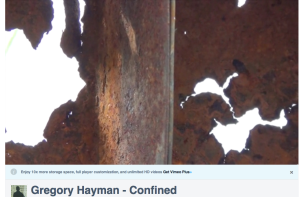Confined/Contained a film
This film is about looking and how things frame what we see. It takes, as its premise, the idea that we are always looking at things through something else, be it a window, building, people, trees, glasses, and screens. If we consider this as given, then framing must to some extent dictate what we see.
The past is also framed by events and its distance in time from where we are. The gatekeepers of the collective memory also frame the past, whether they are historians, politicians, the media and mythmakers. Even the present is subject to the framing of many contingent factors. Our brains also frame things in the selections they make, suggesting that memories are not deliberate but contextualised. Even how we feel about things – whether they are perceived to be good, or bad, is an act of framing. So it might also be presumed that what we forget is also framed by our brains because the act of forgetting suggests that something is disconnecting an experience to render it unnecessary or unworthy of storing.
My film Confined looks through fissures in rusty, corroding metal objects, glimpsing a world beyond. Or so it appears. It could be that the landscape beyond is the object of contemplation in the film. But, it could be that the interior of the boxes and the apertures are the thing being looked at. It is not clear from the point of view of the audience watching the film. And through that slippage lies some of its meaning. Is it the framed we are seeing or the frame?
So is the viewer being tricked into thinking that the subject of the film might be the landscape beyond the boxes? It becomes apparent that this is not the case as the camera does not come to rest on the distant shore line, but instead a couple of grass heads and a fly which alights onto one of them near to the boxes. There is no reveal, no crescendo to wrap the film up. It ends on the incidental the unmemorable.
The film was conceived as an attempt to make another forgettable artwork. It could be seen, as a piece about place or space, but it is not. Although, it does use the language of artworks concerned with place. One viewer believed they saw a building at one point, although none is in the landscape seen. Incidental things happen which can be elevated to the level of significance because of the lack of event in the film, but these again are incidental, like the myriad of small things which we see and forget each hour of everyday.
The film is an attempt to tempt the viewer with something which turns out to be nothing at all, merely the act of looking and listening, the random elevated to the level of art. A frame.
The sound for the film is supposed to be like the sound of the rusty metal interspersed with what appear to be bird song, with jarring repeated bursts of indecipherable percussive noises. The sound is supposed to dislocate from the glimpses of landscape to suggest something industrial perhaps or unreal, an echo of a memory of a soundscape. The sound also acts as a framing devise, albeit, one that was no physical manifestation.
In these senses therefore, I attempt to offer something about memories which bleed though the fissures of the mind to reveal partial glimpses, partial renditions of moments seen but mostly forgotten or not elevated to the status of memories, not burned onto the recallable archives within the brain.
